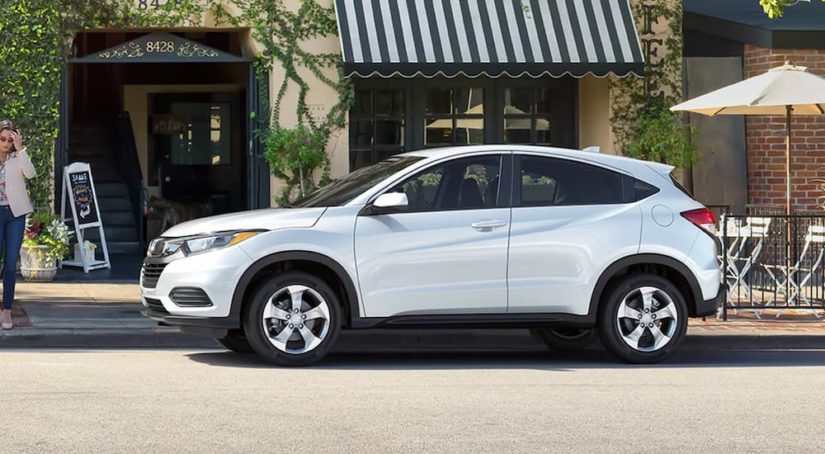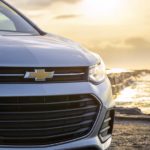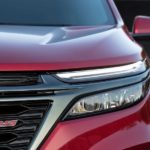Folks looking to buy a subcompact SUV probably aren’t worried about things like powerful engines or fancy suspension systems that tackle tall mountains like a billy goat. If anything, you’re probably more interested in a fair-priced vehicle that has extra cargo capacity and available all-wheel drive so you can make it to work all winter. The subcompact SUV segment is filled with any number of vehicles that want to attract buyer attention with loud colors and gimmicky features, but not all subcompact SUVs resemble child’s toys. If you’re more concerned with getting through snow and mud and want to get great mileage on the highway, there are a few models that deserve a look. In fact, here we’ll compare two such subcompact SUVs with the 2022 Honda HR-V vs 2022 Hyundai Kona.
Most everyone knows the Honda brand for its reliability, quality, and tendency to build efficient vehicles. The 2022 HR-V is now Honda’s smallest available vehicle since the retirement of the Fit, and the HR-V also boasts some innovative ways to tote cargo in the rear space. In the other corner, the 2022 Kona is coming off a refresh with new styling inside and out, with lots of options to add features in upper trims. Even as the Hyundai star rises in the market as a contender against some of the bigger manufacturers, Honda remains a brand known for its resale value and longevity. Which vehicle is the better choice for practical buyers who want a subcompact SUV? Let’s compare these two vehicles to discover how they stack up against each other around performance and cargo capacity.
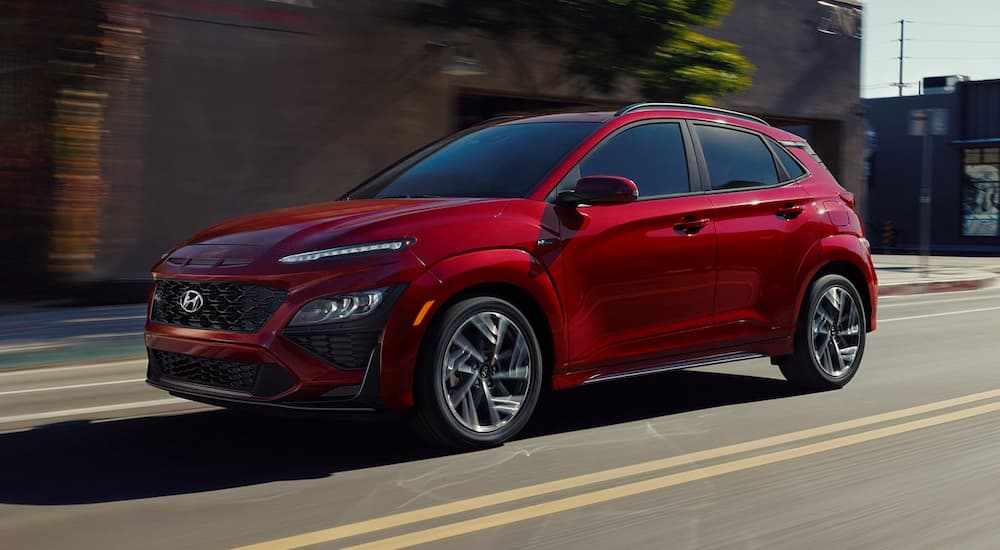
Practical Performance
When it comes to your driving experience, a subcompact SUV isn’t made for speedy getaways like those spy thrillers that involve chases with tiny cars zooming in and out of traffic. The reality of a subcompact SUV is that it will get you places reliably, and the available all-wheel drive can handle snow or slippery roads better than a compact car if you plan to use it as a commuter.
Honda keeps things simple with its single 1.8-liter I4 engine that gets good fuel economy at 28 MPG in the city and 34 MPG on the highway when equipped with the standard front-wheel drive. Opt for all-wheel drive, and efficiency drops slightly to 27 MPG in the city and 31 MPG on the highway. That’s fairly good for an SUV of any kind, and the driving character of the 2022 HR-V is pleasant, the continuously variable transmission is smooth, and the steering is responsive.
At highway speeds, the HR-V cruises affably, and the second-tier Sport trim offers paddle shifters to make driving a little more fun if you enjoy the more engaging feature. Honda has perfected the art of using a CVT in its vehicles, and you probably won’t even notice the difference between this and a traditional automatic transmission that has to run through the gears.
In contrast, the Hyundai offers two engine choices. The two lesser trims come with the 2.0-liter I4 engine that is also paired to a CVT, though this engine is unlikely to feel as confidence-inspiring as the Honda powertrain. Driving with the 2.0-liter under the hood is probably going to make you wish for the better engine in the Kona, as the acceleration is lackluster at best. However, you have to pay for the much more expensive N Line or Limited trims in order to have the 1.6-liter turbocharged I4. That’s not a great option to face if you’re on a budget. Fuel efficiency drops slightly with the more powerful engine, but not by much. Although paired to a less-efficient seven-speed dual-clutch transmission, the turbo engine gets up to 29 MPG in the city and 35 MPG on the highway.
Generally, the turbo engine is the better choice for responsiveness and being able to drive with confidence in the 2022 Kona, though the transmission can feel jittery at low speeds. Truthfully, no matter how many features you may find in the new Kona design, it’s not engineered like a Honda, and the better powertrain is in the HR-V. Take into account winter weather or having to drive on muddy roads, and suddenly ground clearance becomes a thing you really want. The 2022 HR-V has a ground clearance of 7.3 inches, which is excellent for a subcompact SUV. This is close to the larger CR-V, which has 7.8 inches of clearance. Unfortunately, the 2022 Kona only has 6.7 inches of ground clearance, which will make a big difference in deep snow. If you’re buying an SUV to help contend with bad weather, you want the Honda.
Is There Enough Cargo Space?
Owning an SUV of any size should be about the versatility of its interior space and being able to load it up with boxes every time you have to move or go garage sale hunting. Inside the 2022 Kona, despite the opportunity to redesign the interior with more space, Hyundai did not seize the day. The rear cargo area only has 19.2 cubic feet of space for luggage or groceries when the rear seats are in place, though that space does expand nicely into a large 45.8 cubic feet when the seats are folded down. Like so many SUVs, those rear seats don’t really fold completely flat, so you will have to contend with the ramp-like load floor that can make loading long or large items into the SUV annoying at best.
With the 2022 HR-V, cargo space is used about as wisely as one could imagine in a subcompact SUV. For starters, the rear cargo area with the seats in place is larger than the Kona at 24.3 cubic feet (a whole five cubic feet and change more), and when the seats are folded down, it grows to a whopping 58.8 cubic feet. At such a diminutive size, that much cargo room should be impossible, but Honda achieves it…possibly because the rear seats actually fold flat. That alone is a huge win if you plan to use the cargo space often, but then Honda adds another trick to make the rear seats even more versatile: the Magic Seat. Magic is a strong word, but when you flip the lower seat cushion up to make an extra-tall space in the back seat, that’s pretty magical. Instead of just being able to travel with items laid on their sides, taller items like lamps or bikes can be placed upright in the rear seat area of the HR-V.
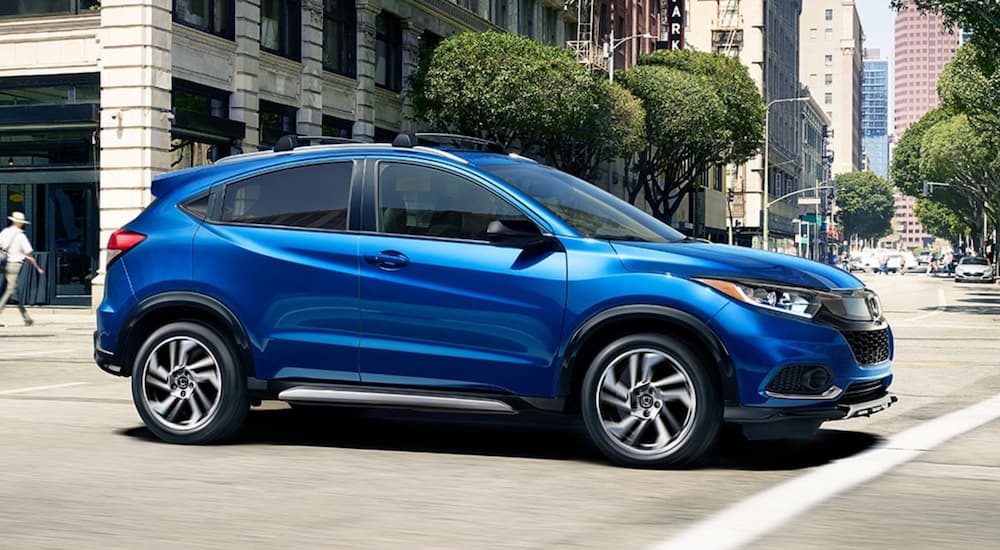
Looking at the Bottom Line
It’s fair to say the 2022 Kona has a lower price than the 2022 HR-V, but it’s not by much. For all practical purposes, they are almost even. Honda lists the entry-level 2022 HR-V at an MSRP of $21,870, while the 2022 Kona starts at an MSRP of $21,150. That’s a difference of $720, though in terms of car pricing, that’s not a big gap, especially if one of those vehicles has a magic seat. All joking aside, for reliable performance and better interior cargo space, the 2022 Honda HR-V will drive better in either dry or adverse weather. You have higher ground clearance and the reputation of a brand that has better resale values than most, which means that when it eventually comes time to sell your HR-V, you are likely to get a better deal than with the 2022 Kona.
